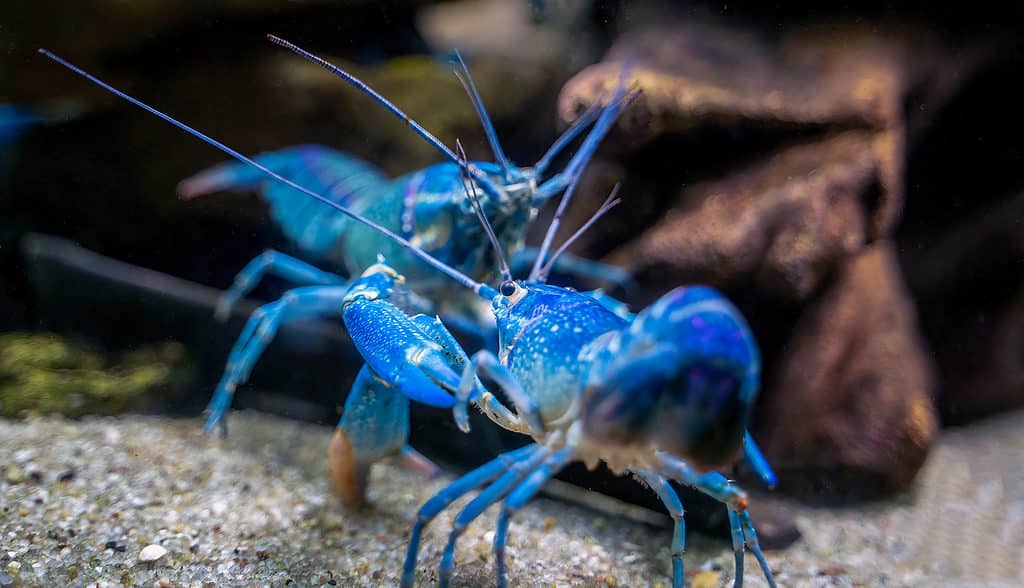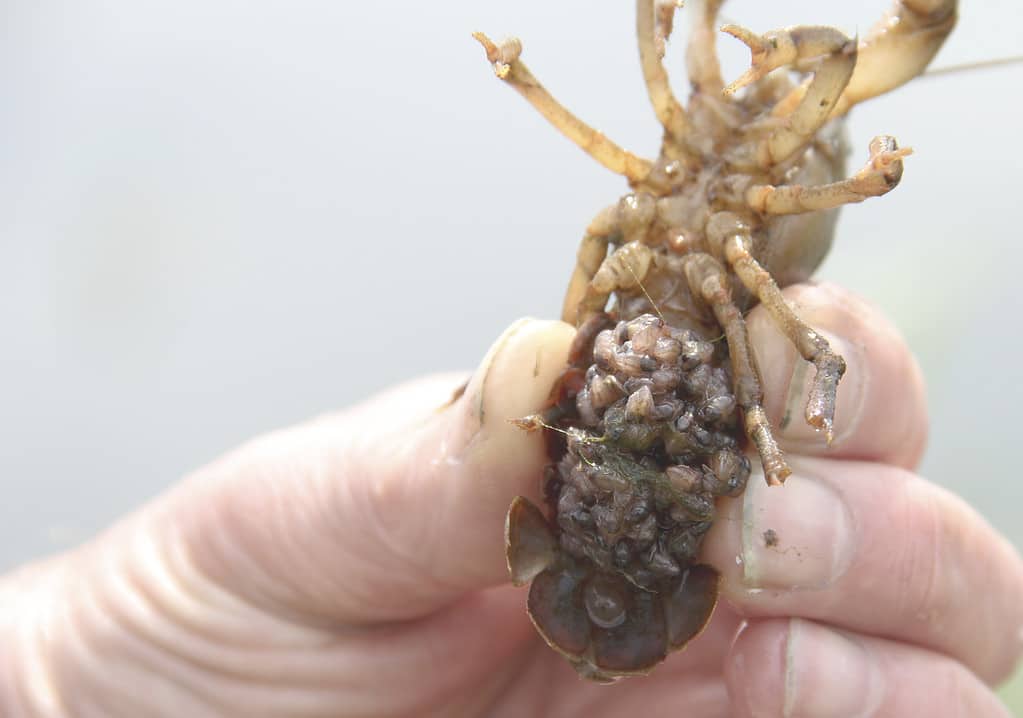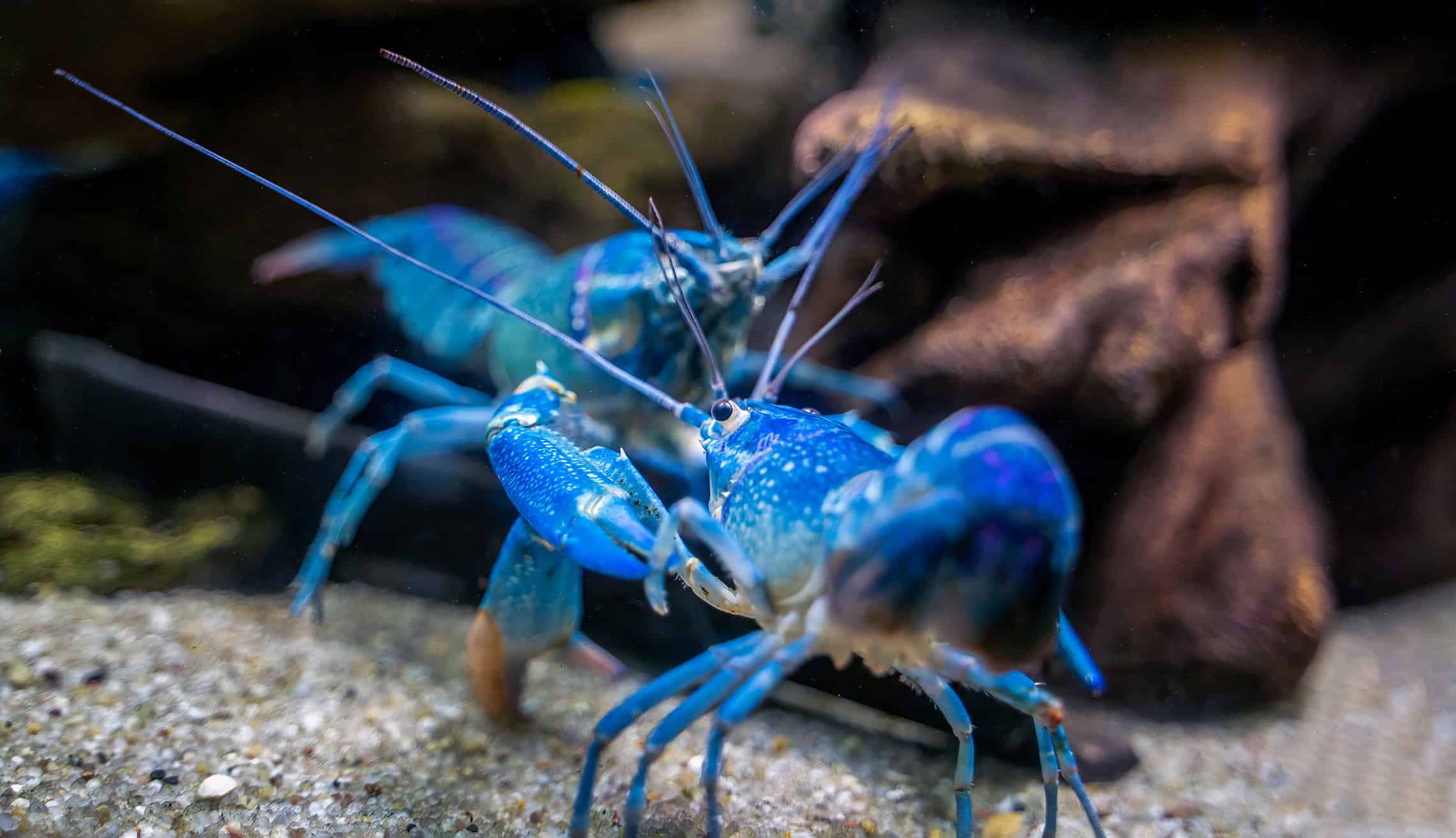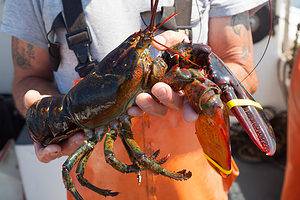Crayfish (also called crawdads or crawfish) are freshwater crustaceans related to the lobster. They have many things in common with their larger crustacean relatives, including reproduction and differences between the sexes. For aquarium enthusiasts, they are interesting pets and can come in colors like electric blue, bright red, and even purple! To others, they are a tasty meal to try to catch in areas where it is legal to hunt them. Spotting the difference between male and female crayfish is useful for breeding and is easy to do once you know what to look for.
Males

Two blue male crayfish fighting for dominance.
©iStock.com/Arpan
Male crayfish have two different “morphs” or forms based on the breeding season. These forms are known as F1 and F2, which are breeding and non-breeding, respectively. In males, this molting occurs twice per year. Molting allows the crustaceans to grow larger out of the confines of their hard exoskeleton. It also gives them some necessary changes needed for breeding.
F1
The F1 or “breeding” form takes place during the breeding season. Most crayfish breed in the late summer or fall, though this can happen any time of year for captive-kept crayfish. It’s easy to overlook the differences between the breeding forms unless you know what you want. Their second pair of walking legs have hook-like projections for holding onto females during mating. Walking legs differ from the swimmerets in location and function: walking legs are larger and attach to the thorax. Swimmerets are used to propel them forward while swimming through the water and are found past the walking legs on the lower abdomen.
Additionally, male crayfish have small legs specifically adapted to deposit sperm, called “gonopods.” This pair of legs is always present in both F1 and F2 forms, but in the F1 form, they become more rigid.
F2
After the breeding season, the male crayfish will undergo its second molting of the year. This is the form they will be in most of the year. In the F2 form, the gonopods become less rigid, and the hooks on their second pair of swimming legs are shed with their molt.
Size
Like many animal species, male crayfish are larger than their female counterparts. This is known as sexual dimorphism, meaning one sex of a species is larger than the other. This doesn’t always imply males are larger than females, though that is typically the case.
Crayfish exhibit this phenomenon quite well, with a larger body size and claws (chelipeds) than females. A male’s claws are larger for fighting off other male crayfish during mating season. However, males will exhibit a more slender body and narrow tail.
Females
While females don’t have different breeding forms, they still undergo a once-yearly molting to grow larger. The physical differences in females are primarily for carrying and swimming with their offspring or larvae.

Crawfish larvae cling to the underside of their mother until maturation.
©Dcwcreations/ via Getty Images
Tail Size
Female crayfish carry their eggs safely underneath their tail for weeks before the larvae can swim and survive independently. To effectively do this, females have wider tails to accommodate these eggs.
Swimmerets
Since female crayfish carry a heavier load with up to 100-150 eggs (or “berries”) at a time, they need strong swimmerets to keep moving through the water. This movement also moves the eggs, keeping them alive and oxygenated. The eggs will develop over a few weeks, and the developed larvae will eventually drop off the mother’s tail. If a young crayfish prematurely falls off its mother’s tail, the mother secretes a hormone to guide the baby back to its mother. Other efforts to keep the offspring safely attached to their undersides are secretions called “glair.” This substance helps adhere the larvae to the mother.
Gonopore
The gonopore is a female-specific organ located towards the bottom of the thorax towards the tail. This is where the female can store the sperm used to fertilize the eggs. It looks like a small, circular opening. If you have multiple crayfish and can flip them on their backs, this is a surefire way to determine whether it is male or female!
Behavior
Generally, it can be assumed males are more aggressive than females. This isn’t entirely untrue, but don’t be mistaken in thinking female crayfish are docile! Both can exhibit aggressive behaviors towards each other or other animals around them. In tanks, you might find your crayfish, regardless of sex, trying to attack nearby fish. However, aggressive behavior can typically be chalked up to mating season, especially between males.
Once a female is “berried” or with eggs, separating her from other tank mates might be best in captivity. This can reduce the chances of the offspring being eaten or the mother crayfish being preyed upon while vulnerable.
Final Thoughts
Determining the difference between male and female crayfish isn’t very important when hunting; it is important for those who want to breed the crustaceans. Crayfish are the same regarding taste, though you might get slightly more meat from a larger male. Knowing a male from a female is invaluable if you’re interested in breeding crayfish for an aquarium hobby. Unlike some species of fish, reptiles, or amphibians, crustaceans cannot self-fertilize. Therefore, you would need a mating pair to produce viable offspring.
If you happen upon a crayfish, whether it’s at a fish store or in the wild, try to use some of these tips to see if you can determine if it is a male or female!
Thank you for reading! Have some feedback for us? Contact the AZ Animals editorial team.








